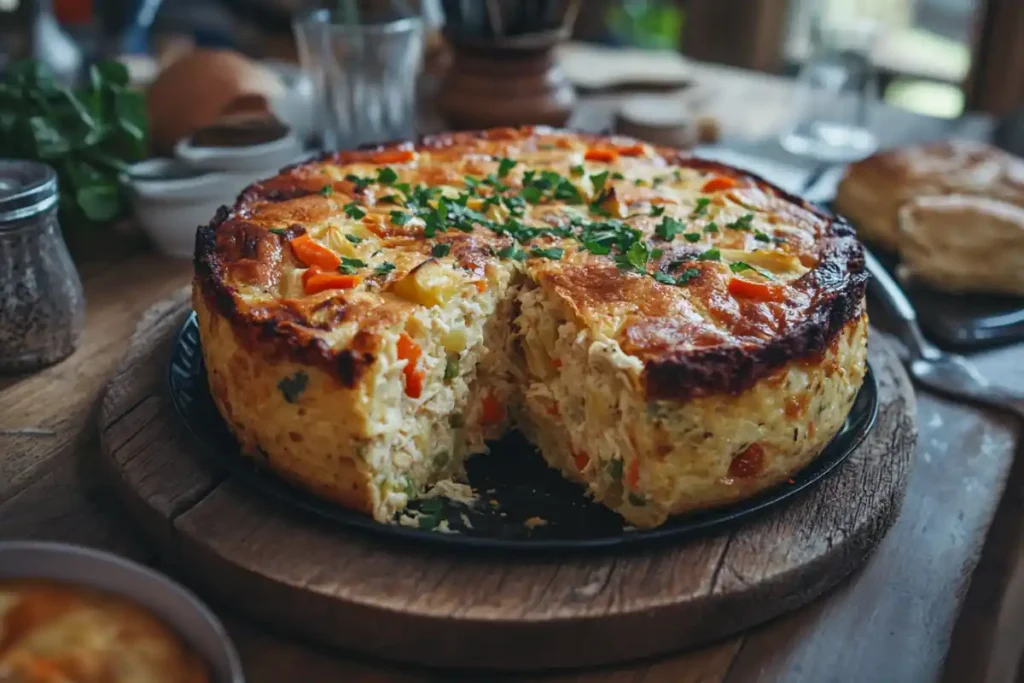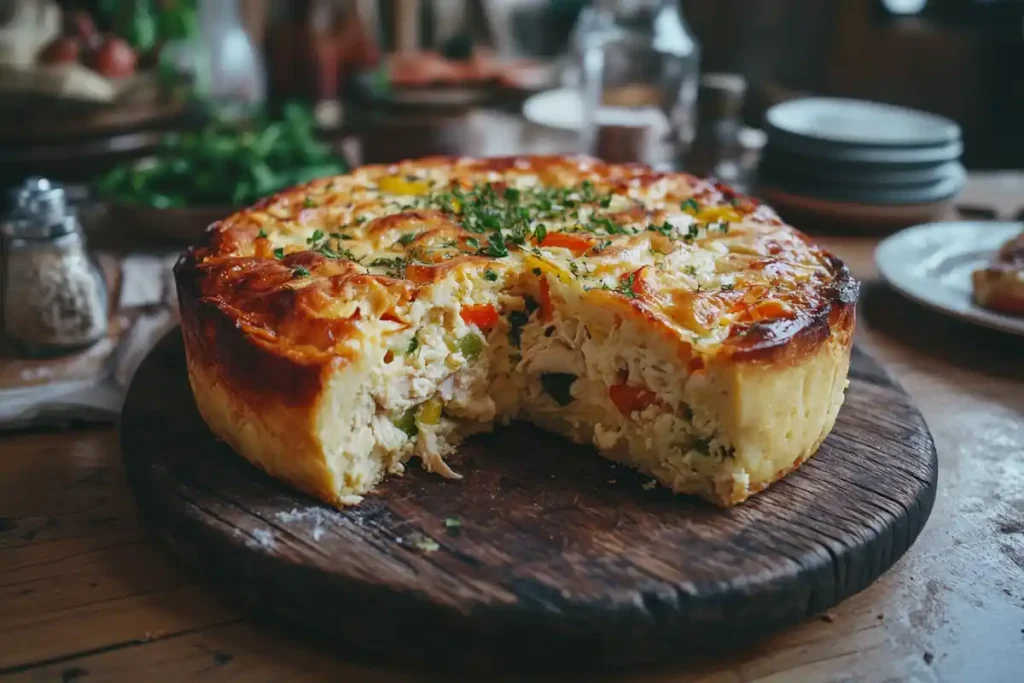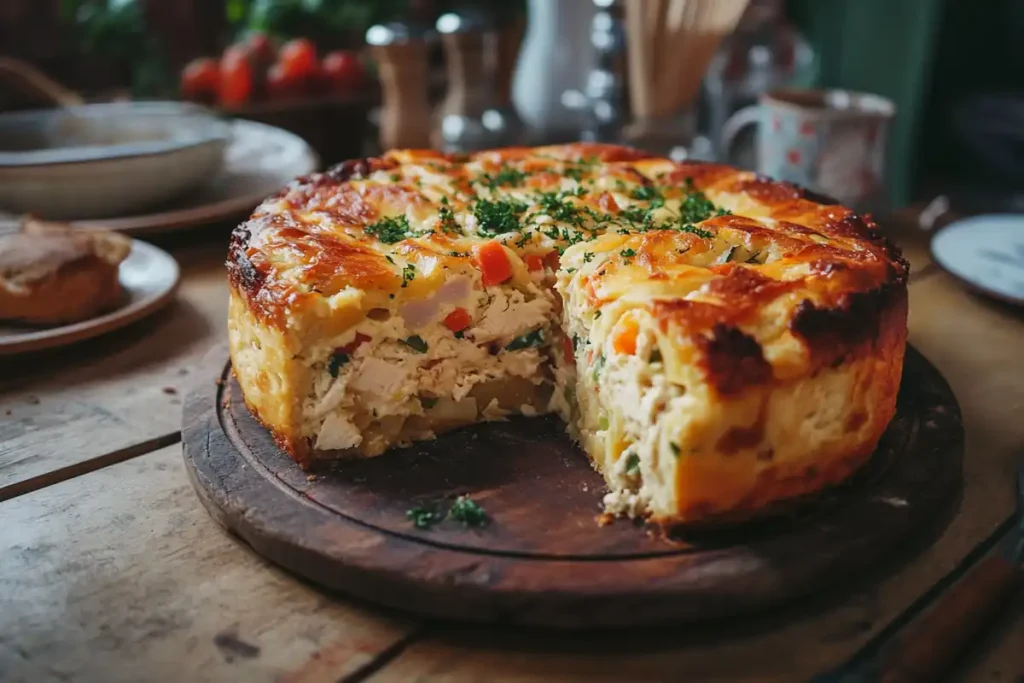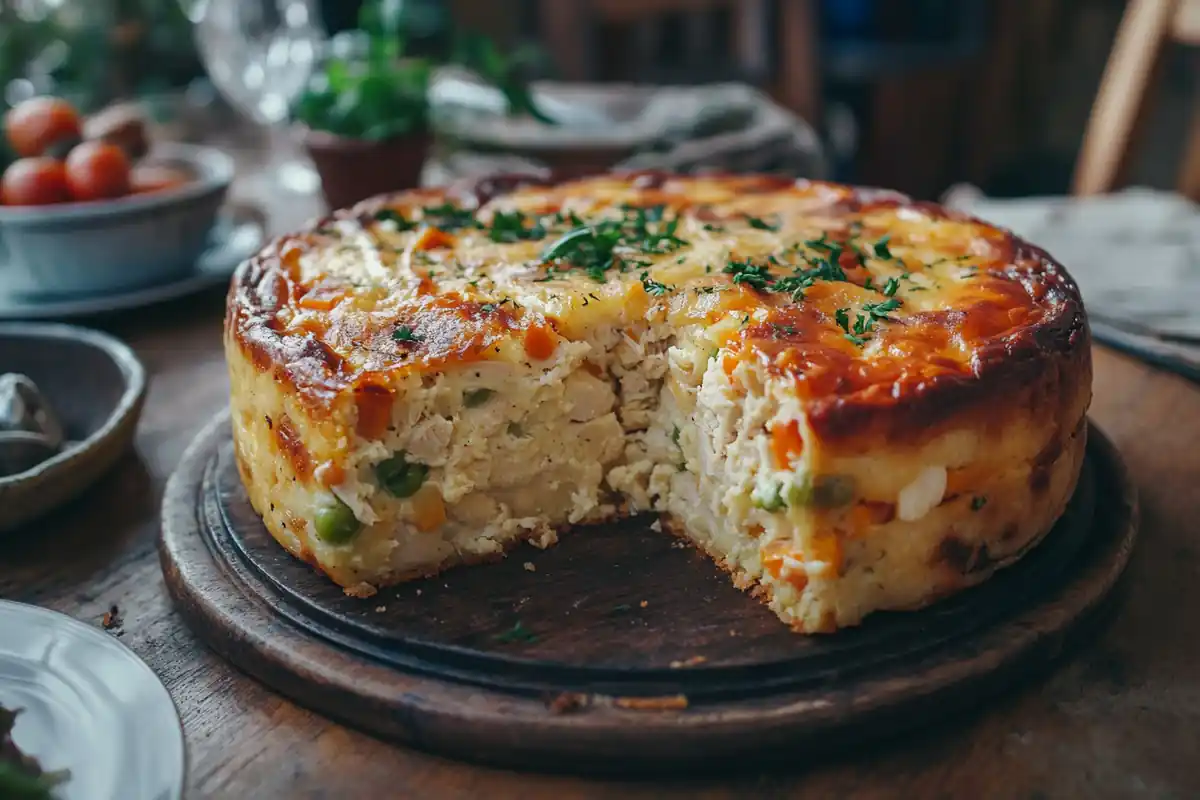Introduction
Fricassee Cake is an innovative and delightful twist on the traditional cake, inspired by the classic culinary technique of fricassee. Unlike conventional cakes that focus solely on sweetness and texture, Fricassee Cake blends savory elements with sweet flavors, creating a harmonious balance that captivates both the eyes and the palate. This unique approach not only elevates the flavor profile but also introduces a sophisticated aesthetic to your dessert repertoire. Whether you’re preparing it for a special occasion or simply indulging in a gourmet treat, Fricasse Cake offers a distinctive experience that stands out in the world of baking.
- Unique Fusion: Combines savory and sweet elements for a balanced taste.
- Sophisticated Presentation: Elegant design suitable for upscale events.
- Versatile Use: Ideal for both casual gatherings and formal celebrations.
For a deeper understanding of how savory techniques can enhance your baking, explore our Divorce Cake and Cloud Cake Recipe for inspiration on creating visually stunning and flavorful cakes.
Historical Background
The concept of Fricasse Cake draws its inspiration from the traditional French cooking method known as fricassee. Originally, a fricassee involves cooking meat in a white sauce, typically with vegetables, resulting in a tender and flavorful dish. Over time, this method has influenced various culinary creations beyond its savory roots, leading to innovative interpretations like Fricassee Cake.
- Origins of Fricassee Cake:
- Inspired by the French fricassee cooking technique.
- Developed as a fusion of savory and sweet baking traditions.
- Cultural Significance:
- Represents the blending of different culinary practices.
- Celebrated in modern baking for its creativity and versatility.
- Influences and Inspirations:
- Incorporates elements from both dessert and main course preparations.
- Utilizes a variety of ingredients to achieve a unique flavor profile.
Understanding the rich history and cultural significance of Fricassee Cake adds depth to your baking, allowing you to appreciate the craftsmanship behind this innovative dessert.
Culinary Variations
One of the most exciting aspects of Fricassee Cake is its adaptability. Bakers can experiment with a range of ingredients and techniques to create personalized versions that cater to diverse tastes and dietary preferences.
- Regional Adaptations:
- European Influence: Incorporates herbs like thyme and rosemary for a Mediterranean twist.
- Asian Fusion: Utilizes flavors such as ginger and sesame to add an exotic flair.
- Ingredient Incorporations:
- Fruits and Nuts: Adds cranberries, apricots, or almonds for added texture and sweetness.
- Spices: Enhances flavor with cinnamon, nutmeg, or cardamom.
- Dietary Adaptations:
- Vegan Options: Uses plant-based substitutes like flaxseed eggs and coconut oil.
- Gluten-Free Versions: Employs alternative flours such as almond or coconut flour.
- Low-Sugar Recipes: Incorporates natural sweeteners like honey or maple syrup.
Exploring these variations not only broadens your baking skills but also allows you to tailor the Fricassee Cake to suit different occasions and dietary needs. For more creative baking ideas, check out our Graduation Cakes and Bishop Cake for inspiration on how to personalize your desserts.
Preparation and Serving of Fricassee Cake

Creating a delicious fricassee cake involves a combination of quality ingredients and effective cooking techniques. This section provides a comprehensive guide to preparing and serving the cake, ensuring a satisfying and flavorful result every time. From a detailed recipe to essential cooking tips, you’ll find everything you need to master this innovative twist on a classic dessert.
Step-by-Step Recipe for Fricassee Cake
Preparing a fricassee cake is a straightforward process that yields a visually stunning and flavorful loaf. Follow these steps to create a perfect balance of savory and sweet elements while maintaining the cake’s structure and taste.
Ingredients:
| Ingredient | Quantity |
|---|---|
| All-Purpose Flour | 2 cups |
| Granulated Sugar | 3/4 cup |
| Unsalted Butter | 1/2 cup, softened |
| Eggs | 2 large |
| Baking Powder | 1 teaspoon |
| Salt | 1/2 teaspoon |
| Vanilla Extract | 1 teaspoon |
| Milk | 1/2 cup |
| Cinnamon | 1 teaspoon |
| Nutmeg | 1/2 teaspoon |
| Optional Add-ins | 1 cup of walnuts, pecans, or chocolate chips |
Instructions:
- Preheat the Oven and Prepare the Pan:
- Preheat your oven to 350°F (175°C).
- Grease a loaf pan or line it with parchment paper to ensure easy removal of the cake.
- Mix Wet Ingredients:
- In a large mixing bowl, cream together the butter and granulated sugar until light and fluffy.
- Beat in the eggs one at a time, ensuring each is fully incorporated.
- Stir in the vanilla extract.
- Combine Dry Ingredients:
- In a separate bowl, whisk together the all-purpose flour, baking powder, salt, cinnamon, and nutmeg.
- Gradually add the dry ingredients to the wet mixture, alternating with milk, starting and ending with the dry ingredients. Mix until just combined to avoid overmixing.
- Add Optional Mix-ins:
- Fold in any optional add-ins like walnuts, pecans, or chocolate chips for added texture and flavor.
- Pour and Shape the Batter:
- Pour the batter into the prepared loaf pan, spreading it evenly.
- For a more defined shape, gently tap the pan on the countertop to remove any air bubbles and ensure the batter settles uniformly.
- Bake the Cake:
- Place the pan in the preheated oven and bake for 60-70 minutes, or until a toothpick inserted into the center comes out clean.
- To maintain the cake’s shape, avoid opening the oven door frequently during baking.
- Cool and Serve:
- Allow the cake to cool in the pan for about 10 minutes before transferring it to a wire rack to cool completely.Slice the fricassee cake into clean, even pieces to showcase its balanced texture.
Cooking Techniques Specific to Fricassee Cake
Mastering the right cooking techniques is essential for preparing a flavorful and perfectly structured fricassee cake. Here are some methods to enhance your baking process:
Proper Mixing Methods
- Avoid Overmixing:
- When combining the wet and dry ingredients, mix just until they are incorporated. Overmixing can lead to a dense and tough texture.
- Creaming Butter and Sugar:
- Cream the butter and sugar thoroughly to incorporate air, which helps in achieving a light and fluffy cake.
Shaping Techniques
- Choosing the Right Pan:
- Use a loaf pan with straight sides to help maintain the cake’s structure and shape.
- Even Batter Distribution:
- Pour the batter evenly into the pan and gently tap it on the countertop to settle the batter and eliminate air pockets.
Baking Tips
- Consistent Oven Temperature:
- Ensure your oven is properly preheated and maintains a consistent temperature throughout the baking process to achieve an even bake.
- Checking for Doneness:
- Insert a toothpick into the center of the cake. If it comes out clean or with a few moist crumbs, the cake is done. If not, continue baking and check every 5 minutes.
For more baking tips, check out our Difference Between Hotcake and Pancake to refine your batter consistency and cooking methods.
Nutritional Information
Fricassee cake is not only a treat for the taste buds but also offers various nutritional benefits, making it a wholesome addition to your diet.
Health Benefits of Main Ingredients
- Bananas:
- Rich in potassium, vitamin C, and dietary fiber, bananas contribute to heart health, digestion, and immune function.
- Whole Grains:
- Using all-purpose flour provides essential carbohydrates for energy. Opting for whole grain or alternative flours can increase fiber content.
- Nuts and Seeds:
- Adding walnuts or pecans introduces healthy fats, protein, and omega-3 fatty acids, supporting brain health and reducing inflammation.
Nutritional Breakdown (Per Serving):
| Nutrient | Amount |
|---|---|
| Calories | Approximately 250-300 kcal |
| Protein | 5-7g |
| Carbohydrates | 35-40g |
| Fiber | 3-5g |
| Fat | 10-15g |
| Vitamins & Minerals | Rich in potassium, vitamin C, and iron |
Comparison with Traditional Cakes
Fricassee cake maintains the same core nutritional benefits as traditional cakes but offers added value through its unique blend of savory and sweet elements. The inclusion of nuts and reduced sugar options can make fricassee cake a more balanced choice compared to classic recipes.
For those interested in exploring more nutritious baked goods, our Vegan Cream Cheese article provides alternatives that can enhance the nutritional profile of your fricassee cake.
Serving Suggestions and Presentation

Serving fricassee cake with complementary sides and garnishes can elevate the dining experience, making it perfect for various occasions.
Traditional Accompaniments:
- Fresh Fruits:
- Serve alongside a bowl of fresh berries or sliced fruits to add a refreshing contrast to the cake’s rich flavors.
- Dairy Options:
- Pair with a glass of milk, coffee, or tea for a balanced meal.
- Spread Options:
- Offer spreads like butter, jam, or nut butters to enhance the flavor.
Presentation Tips:
- Even Slicing:
- Use a sharp serrated knife to slice the cake cleanly, maintaining its structured appearance.
- Plating:
- Arrange slices on a stylish platter with garnishes such as a dusting of powdered sugar or a drizzle of honey.
- Garnishing Ideas:
- Top with a sprinkle of cinnamon, chopped nuts, or a dollop of whipped cream for added flavor and visual appeal.
For more presentation ideas, explore our 4-Ingredient Pasta Salad for a quick and tasty side dish that complements your fricassee cake perfectly.
Variations and Substitutions
One of the strengths of fricassee cake is its versatility. You can customize the recipe to suit your taste preferences and dietary needs, allowing for endless creative possibilities.
Adding Different Mix-Ins:
- Nuts and Seeds:
- Incorporate walnuts, pecans, or sunflower seeds for added crunch and nutrition.
- Chocolate Chips:
- Add chocolate chips or cocoa nibs for a sweet and indulgent touch.
- Dried Fruits:
- Mix in raisins, cranberries, or dried apricots for bursts of flavor.
Using Alternative Sweeteners or Flours:
- Sweeteners:
- Substitute granulated sugar with honey, maple syrup, or coconut sugar for different sweetness levels and flavors.
- Flours:
- Use almond flour or whole wheat flour to create gluten-free or higher-fiber versions of the cake.
Substituting Ingredients for Dietary Preferences:
- Vegan Options:
- Replace eggs with flaxseed meal or applesauce to make the cake vegan-friendly.
- Gluten-Free:
- Use a combination of gluten-free flours to cater to those with gluten sensitivities.
- Low-Sugar:
- Reduce the amount of sugar or use natural sweeteners to create a healthier version without compromising taste.
Exploring these variations not only broadens your culinary skills but also allows you to tailor the fricassee cake to suit different dietary preferences and occasions. For more creative baking ideas, check out our Graduation Cakes and Bishop Cake for inspiration on how to personalize your desserts.
FAQs, Tips, and Additional Resources for Fricassee Cake

Frequently Asked Questions about Fricassee Cake
What does Fricassee mean in cooking?
Fricassee is a French cooking technique where meat is sautéed and then braised in a creamy sauce. For fricassee cake, this method inspires the blend of savory and sweet flavors, creating a unique dessert experience.
How do you fricassee something?
To fricassee traditionally:
Sauté the meat in butter until browned.
Add aromatics like onions and garlic.
Deglaze with broth or wine.
Braise until tender.
What’s the difference between stew and fricassee?
Stew: Involves slow-cooking larger meat chunks in liquid.
Fricassee: Starts with sautéing meat before braising in a creamy sauce.
What is the origin of chicken fricassee?
Chicken fricassee originated in France as a way to tenderize and flavor tougher chicken cuts. This technique has influenced various culinary creations, including fricasse cake, where the principles of blending flavors are applied to baking.
Can I make fricassee cake ahead of time?
Yes, you can prepare fricassee cake ahead:
Refrigerate: Store in an airtight container for up to a week.
Freeze: Wrap tightly and freeze for up to three months.
Reheat: Warm slices in the oven or microwave before serving.
What are common mistakes when making fricassee cake?
Overmixing: Can make the cake dense. Mix until just combined.
Incorrect Leavening: Measure baking powder accurately to ensure proper rise.
Underbaking/Overbaking: Use a toothpick to check doneness to avoid a gooey center or dry texture.
Cooking Tips and Tricks for Fricassee Cake
Enhancing your fricassee cake involves more than just following a recipe. Here are some valuable tips and tricks to elevate your baking experience.
Enhancing Flavors in Fricassee Cake
- Use Fresh Ingredients: Fresh bananas, high-quality butter, and aromatic spices significantly boost the cake’s flavor.
- Proper Seasoning: Taste your batter before baking and adjust salt and spices as needed to achieve the perfect balance.
- Quality Vanilla Extract: A high-quality vanilla extract enhances the overall flavor profile, adding depth and warmth.
Ensuring Moistness in Fricassee Cake
- Do Not Overmix: Mix ingredients until just combined to retain moisture and ensure a tender crumb.
- Add Yogurt or Applesauce: Incorporating yogurt or applesauce can add extra moisture without altering the taste, making the cake more succulent.
- Proper Baking Time: Bake until a toothpick comes out clean to avoid overbaking, which can dry out the cake.
Maintaining Shape in Fricassee Cake
- Use the Right Pan: An angular loaf pan or a loaf pan with straight sides helps maintain the cake’s structure and shape.
- Even Batter Distribution: Pour the batter evenly into the pan and gently tap to settle the batter and eliminate air pockets, ensuring a uniform shape.
Storing and Reheating Fricassee Cake
- Cool Completely: Allow the cake to cool completely before slicing to maintain its shape and texture.
- Store Properly: Keep in an airtight container to retain freshness. Store at room temperature for up to two days or refrigerate for longer storage.
- Reheat Gently: Reheat slices in a toaster or microwave for a warm and delightful treat. Adding a bit of butter or oil can help revive moisture and flavor.
Conclusion
Mastering fricassee cake involves understanding its unique blend of savory and sweet flavors, applying effective baking techniques, and utilizing available resources to enhance your culinary skills. By addressing common questions, implementing useful tips, and exploring additional resources, you can create a cake that is both hearty and tailored to your personal preferences. Whether you’re a seasoned baker or a beginner, these insights will help you enjoy a delicious and satisfying loaf that embodies the creativity and warmth of modern baking.
For more creative and unique baking ideas, explore our Divorce Cake and Cloud Cake Recipe to complement your fricassee cake and inspire your next baking adventure

